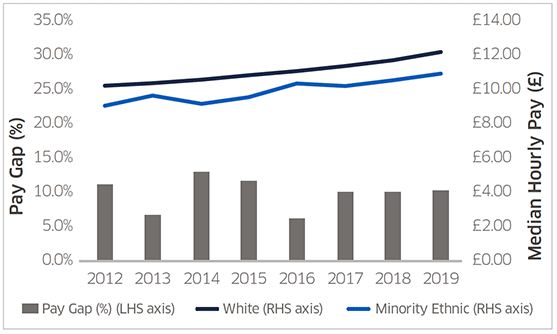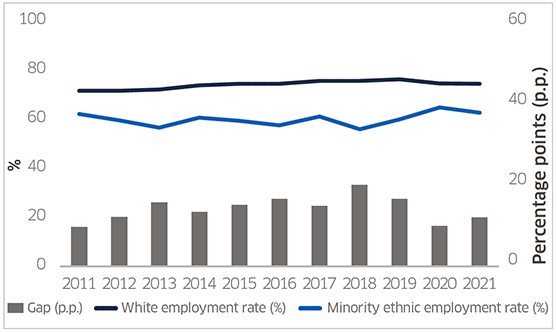Anti-racist employment strategy - A Fairer Scotland for All
The strategy is a call for action and a guide to address the issues and disadvantage experienced by people from racialised minorities in the labour market in Scotland. It is a key component in achieving our ambition to become a leading Fair Work Nation by 2025.
Introduction
This strategy has been developed in response to the persistent inequality that exists within the labour market for racialised minorities. There is recognition that more needs to be done to address this and the systemic and structural issues that reinforce it.
The strategy takes an anti-racist and intersectional approach. An anti-racist approach means it is no longer enough to be just against racism, but to be active in taking steps to challenge and address it. This applies to both people and organisations. It means challenging and changing organisational structures, policies, practices, and attitudes so that nobody is discriminated against in the workplace. Taking an intersectional approach means people recognise, and policies reflect, that racism does not sit in isolation and that other inequalities can exist which make entering and progressing in the workplace more difficult.
An anti-racist approach is the reason for the strategy adopting terms such as racialised minorities when referring to those impacted negatively because of their race or ethnicity. It recognises that our systems and processes in society, including the labour market, are structured in a way that disadvantages certain groups. This disadvantage affects those from different ethnic backgrounds.
"Racialisation is the process by which groups of people are given racial identities and placed within the hierarchy based on their presumed superiority or inferiority to one another."[16]
It is this process within society and in our systems which have historically created and reinforced racial inequality. We see racial inequality in the labour market through the employment gap and the ethnicity pay gap, which indicate a variety of issues experienced by racialised minorities in the labour market.
We recognise this terminology will be new to some. We are using it because it is important to highlight this process of racialisation and how it impacts and affects different groups in our society. Through highlighting it, and encouraging other employers to understand it, it forces the onus on systems, institutions, policies and practices to change to address inequality rather than on those impacted by it.
Using these terms within our strategy does not change our position of respecting everyone's right to self-identify according to the term they relate to or are most comfortable with, such as minority ethnic or black and minority ethnic or a person of colour.
Employers should use the terms that work for all staff in their organisation and be able to explain the reason for the terms they use (e.g. it's what their staff feel is most appropriate). This is likely to differ across employers and their workforces.
The evidence base for this strategy
There is substantive labour market data which shows inequality for racialised minorities.
It should be noted that the term 'minority ethnic' is used in labour market analysis, equality analysis and statistical indicators such as the ethnicity pay or employment rate gaps, and not 'racialised minorities'.
The ethnicity pay gap and employment rate gap are useful high level indicators of inequality and a reminder of the persistent disparities that exist between white workers and 'minority ethnic' workers.

Source: Annual Population Survey, Jan-Dec 2012-2019

Source: Annual Population Survey, Jan-Dec 2011-2021
The importance of addressing racial inequality
Employers should see the benefits of addressing racial inequality in many ways. In becoming a leading Fair Work Nation, it will not just mean employers taking forward fair working practices in terms of pay and job security but also having workplaces that are truly inclusive and reflective of Scotland's diverse population. It is right that the labour market should have the conditions that mean everyone is treated fairly and equally.
There will always be a moral imperative to ensuring everyone in Scotland is treated fairly in the labour market. That should always be the first and most important consideration.
In doing this employers are also making good business choices that lead to better outcomes. This includes:
- Greater profitability
Research has shown that companies in the top-quartile for ethnic/cultural diversity on executive teams were 33% more likely to have industry-leading profitability. A diverse workforce makes good business, economic and societal sense.[17]
- Reduced economic loss because there is the full participation of racialised minority individuals, including better staff retention and engagement.
"The potential benefit to the UK economy from full representation of BME individuals across the labour market, through improved participation and progression, is estimated to be £24 billion a year, which represents 1.3% of GDP [Gross Domestic Product]."[18]
- Improved corporate reputation
Research has shown that people want to work for employers with good employment practices. In a UK survey by the Institute of Business Ethics, 85% of female millennials say that an employer's policy on diversity, equality, and workforce inclusion are important factors when deciding whether or not to work for them.[19]
Our aim
The aim of this strategy is to:
- Address issues experienced by racialised minorities that lead to inequality in the labour market
- Increase the number and impact of actions that employers are taking to address racial inequality in their workplace.
We will do this by:
- Establishing a suite of actions for the Scottish Government, supported by employers across the economy.
- Providing employers with practical steps, guidance and resources to take a proactive approach on this agenda.
What success will look like:
- The number of people entering the labour market and staying in and progressing in an organisation is closer to and representative of that organisation's local population.
- The number of employers addressing intersectional barriers in their workplaces has increased. This means an increase in the number of employers implementing or improving policies and processes across recruitment, retention and progression, to prevent the compounded disadvantage experienced by people with multiple protected characteristics e.g. race, gender and disability.
- The number of employers proactively creating safe, diverse, and inclusive workplaces has increased. This means an increase in the number of employers creating workplaces where racialised minorities have safe spaces such as staff networks, where they do not experience discrimination, bullying or harassment and where they can feel safe and supported to challenge inappropriate behaviour.
- The number of employers taking forward informed and evidence-based actions, that lead to improvements in pay, commitment and conditions for the entire workforce, has increased. This includes seeing an increase in the number of employers impact assessing policies and processes across recruitment, retention and progression to ensure equal outcomes for all members of staff.
The strategy will complement existing activity by employers across the UK who are working to address racial inequality, such as reporting and acting on their pay gaps to increase representation and support progression and retention.
For employers who operate across the UK, we encourage and expect them to take the Fair Work approach for operations in Scotland. Fair Work principles and supporting guidance should be taken account of when bidding on public contracts, for example. This will be actioned through our commitment to strengthen Fair Work First criteria.
Contact
Email: raceemployment@gov.scot
There is a problem
Thanks for your feedback